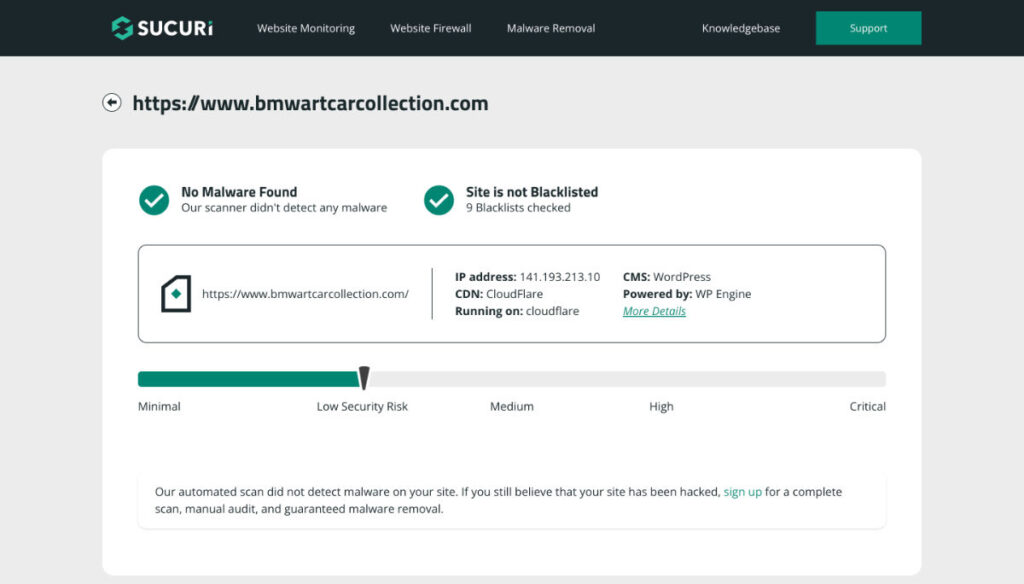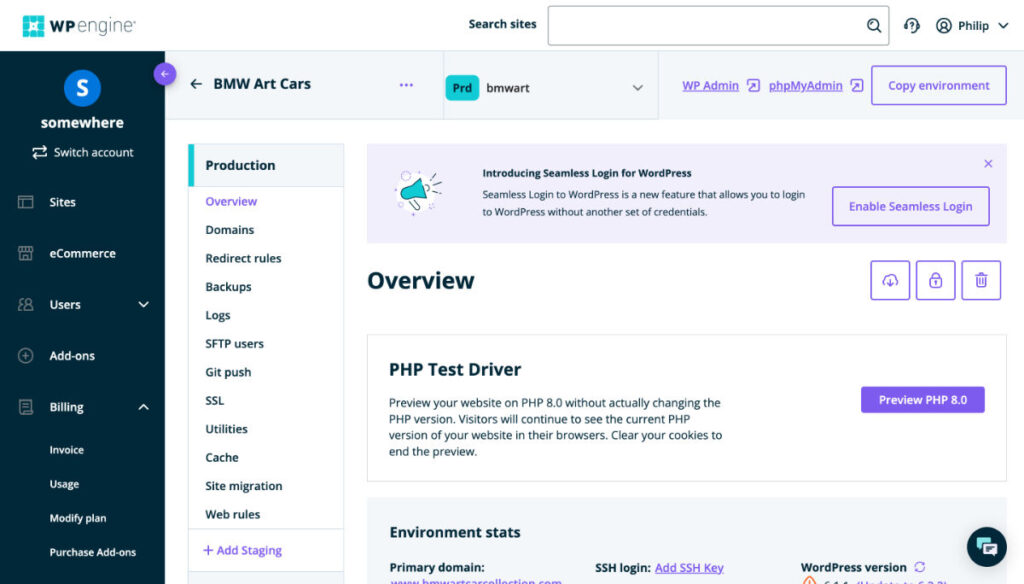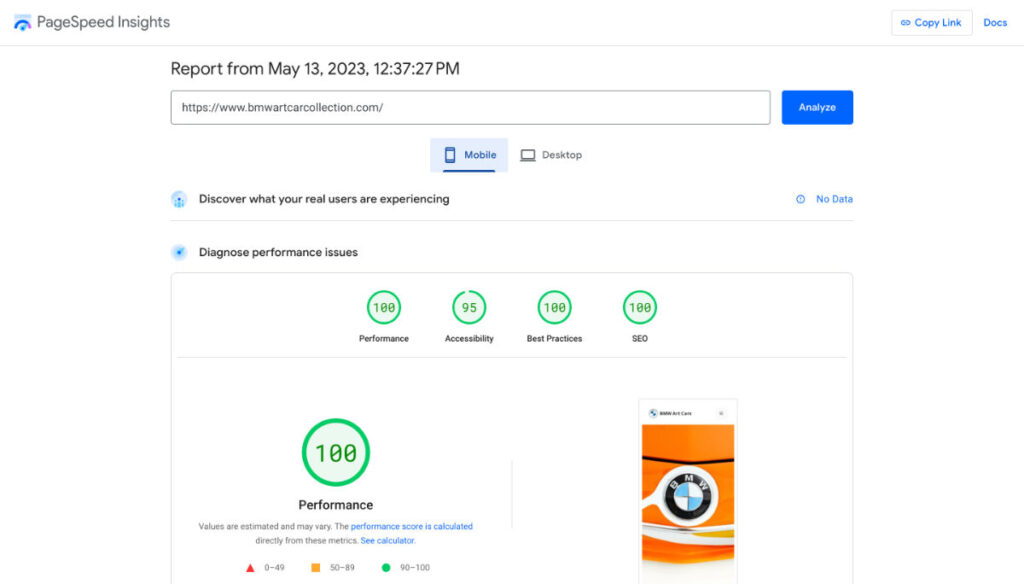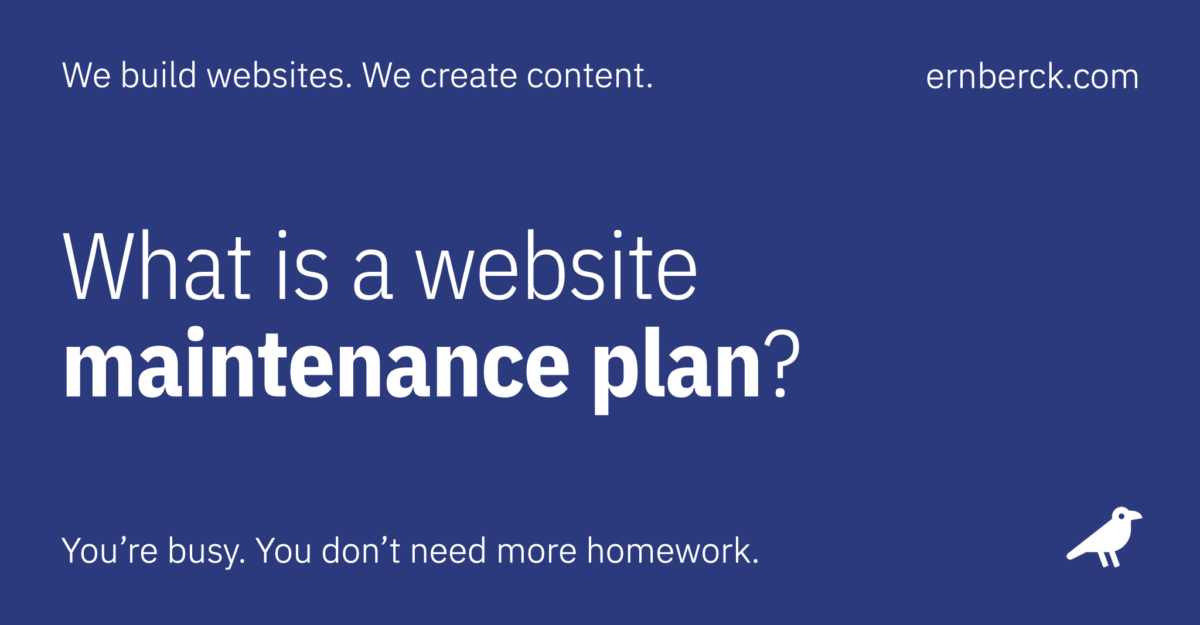If you build a website you can’t manage or promote, you haven’t solved a problem — You’ve created one. Launching a website isn’t the end of the process, it’s just the beginning. You need a maintenance plan.
What is a website maintenance plan?
Websites require ongoing attention to stay secure, functional, relevant, and effective. A website maintenance plan (or support plan) is a structured approach to managing and updating a website to ensure it remains safe, reliable, and up-to-date.
Most marketing agencies and web designers offer three or four levels (tiers) of maintenance plans for a recurring monthly fee. The longer the list of features, the more you pay. These subscription packages often have hourly limits on personal support that don’t roll over to the next month.
What features does a typical maintenance plan include?
There are no standards, regulations, or “best practices” governing what a website maintenance program includes, so it’s often tough to compare plans. To complicate things, monthly fees vary widely and the list of features you might find in any given maintenance plan is lengthy.
Here are 15 of the most common support tasks:
01. Website backups
Create regular backups of the website’s files, media, and database to enable quick recovery in the case of data loss, software conflicts, hacking, or other emergencies.
02. Software updates
This includes routine updates to the website’s core software, themes, plugins, and other components to ensure they’re current and secure.
03. Security audits
Run routine security scans to help protect the website from hacking, malware, and other online threats. This includes regular software monitoring, as well as the implementation of security plugins and diagnostic tools.

04. Performance audits
Monitor website performance, optimize page loading times, and ensure that your website functions smoothly on various devices and browsers.
05. Quality assurance
Conduct regular quality assurance tests to identify and resolve issues before they affect website usability. This often includes frequent scanning of the website for broken links, page errors, and security problems.
06. Traffic analysis
Monitor website traffic, user behavior, and search engine performance. If necessary, generate reports to track progress and identify areas for improvement. This often goes hand in hand with SEO (see below).
07. Search engine optimization (SEO)
Ongoing SEO management to improve search rankings and visitor engagement. SEO management is often a completely separate — and costly — service.
Jargon explained
If you’re new to website design and support, it’s easy to get overwhelmed by all the buzz words, acronyms, and technical jargon. It bugs us too, so we assembled some brief descriptions to help clarify website maintenance plans.
08. Design enhancements
Implement design, navigation, and layout improvements to elevate the overall user experience (UX).
09. Privacy compliance
Help ensure that your website complies with any regional, national, or international legal requirements, such as data privacy regulations (GDPR, CCPA, etc).
10. Accessibility compliance
Help make sure that your website is designed and developed in a way that people with disabilities can use it without any hindrance.
Note: Website accessibility requirements are still being debated by government agencies. Consequently, nobody can guarantee full accessibility compliance.
11. Content updates
Minor updates or revisions to website content — such as text, images, and videos — to keep information fresh and engaging. This may include adding new blog posts, product listings, or news articles.

12. Social media management
The regular sharing and posting of original content to your social media accounts (Facebook, Instagram, TikTok, LinkedIn, etc). This often includes help developing a social media strategy.
Note: Social media and pay per click (PPC) advertising are often handled by marketing agencies who specialize in the field.
13. Consultation and strategy
Provide advice on website strategy, growth opportunities, competitors, positioning, and how to leverage your website to achieve business objectives.
14. Customer support
Dedicated one-on-one customer support and communication channels for quick response to website problems, client inquiries, and requests.
15. Regular reporting
Provide regular monthly reports on website performance, security, modifications, updates, and other relevant topics to keep you informed.
Yeah, that’s a lot of stuff. And this is by no means an exhaustive list. You should also be aware that most competent website hosts include a lot of these maintenance chores in their standard hosting plans. Unfortunately, it’s not uncommon for marketing agencies to stuff their support lists with maintenance items that are already included in your hosting plan. Always check the fine print to make sure you’re not being charged twice.
How much do maintenance plans cost?
Maintenance plans are typically offered on a subscription basis and their cost can vary widely. As a rough estimate, basic maintenance plans may start at around $50 to $100 per month, while more comprehensive plans can range from $100 to $500 per month or more. Here’s an overview of the different factors that can influence the cost of a website maintenance plan:
Scope: The more comprehensive the maintenance plan, the higher the cost. Basic plans that include essential updates and security checks tend to be more affordable. Plans with a wide range of services, such as SEO optimization, content updates, and advanced security, can be much more expensive.
Frequency: Most maintenance plans are offered on a monthly basis, while others may be weekly, quarterly, semi-annually, or annually. The more frequent the updates, the higher the annual cost.
Complexity: The complexity of your website plays a significant role in determining the cost. Large, complicated websites — like ecommerce or membership sites — with hundreds (or thousands) pages, intricate features, and custom functionality require more maintenance and incur higher costs.
Provider: The cost of website maintenance plans can vary among service providers, even for the same features. Larger agencies often charge more than independent professionals. Expertise and reputation also influence pricing.

Ecommerce: As noted above, websites with ecommerce functionality or complex databases often require more maintenance and security measures, which can increase the cost.
Emergency support: Some maintenance plans include 24/7 emergency support, which may come at a premium price.
Platform: The content management system (CMS) or platform your website is built on can impact the cost. Maintenance for popular platforms like WordPress may be more competitive, while custom-built websites or less common platforms could be more expensive.
Location: Prices for website maintenance services can vary by geographic location. Urban areas with a higher cost of living may have higher prices than less expensive rural regions.
Customization: Customized maintenance plans tailored to your specific needs are likely to cost more than pre-packaged plans, but they can provide the exact services your website requires.
It’s essential to evaluate your own specific needs and budget. Request estimates from multiple service providers, and carefully review the details of each plan to determine which one aligns best with your objectives and resources. Keep in mind that investing in website maintenance is a crucial part of ensuring the long-term success of your website — And your business.
Full disclosure: Ern Berck Digital currently offers three different support plans priced at $200, $400, and $800 per month. We can also create a custom care plan tailored to your specific goals and resources.
What are the drawbacks of a website maintenance plan?
Website maintenance plans offer tremendous benefits, but there are also potential challenges associated with them. Some of the drawbacks you should be aware of include:
Cost: Website maintenance plans incur ongoing costs, especially when outsourcing maintenance to professionals or agencies. As discussed above, these costs vary depending on the complexity of the plan and the services included.
Dependency: Relying on a third party for maintenance can create a dependency, leaving you with less direct control over updates and changes. If the provider has problems or goes out of business, it can impact your website’s reliability.
Communication: Effective communication with your provider is crucial for a maintenance plan to work well. Misunderstandings or delays in communication can lead to issues not being addressed promptly. This is a frequent problem with outsourced technical support.
Quality: The quality of support services can vary widely among providers. Choosing an inexperienced or unreliable provider may result in subpar maintenance efforts.
Over-servicing: Some support providers may suggest additional services (upselling) that are not necessary — or even detrimental — leading to higher costs. It’s important to assess the value of each service offered.
Under-servicing: Conversely, some providers may offer minimal maintenance and overlook critical tasks, leaving the website vulnerable to serious issues.
Security: While maintenance can enhance security, it can also raise security concerns if a provider has access to sensitive website data. Proper agreements and security protocols should be in place to address this issue.
Downtime: Despite proactive maintenance, there may be instances of downtime due to updates or maintenance activities. It’s important to plan for scheduled maintenance and communicate it to users.
Scalability: As your business grows, your website maintenance plan may need to be adjusted to accommodate increased traffic, content, and functionality. This can require additional investment and effort.
Limited customization: Pre-packaged maintenance plans may not fully align with the unique needs and goals of your website, and customization may be limited.
To mitigate these challenges, it’s crucial to choose a reputable and experienced service provider, clearly define the scope of services, establish expectations, and regularly review the value of your plan. Additionally, you might consider managing some aspects of maintenance in-house to maintain a level of control and reduce costs.
Couldn’t I maintain a website myself?
Sure. With some comprehensive initial instruction and ongoing education, you could likely add content and keep your site secure and reliable. That said, your website is one of your most important business assets. So it’s vital that you keep it updated, protected, and available so it can serve your customers.
If you’re confident that you can do it yourself, below are five bare minimum tasks that you’ll have to master to keep your website safe and secure:
01. Backups
With a full backup of your website, you can restore it to any hosting provider, even in the worst situations.
02. Security
If your website doesn’t offer a basic level of security, you’ll have to install a robust and reliable security plugin yourself.
03. Updates
This may include everything from server software to plugin, theme, and platform updates.
04. Performance
Visitors no longer tolerate slow websites and dozens of undesirable conditions can affect performance. Knowing how to correct them is critical.
05. Content
The web thrives on engaging content. If you don’t publish regularly, you’ll lose visitors and search rankings.
Again, these are the bare minimum tasks that you’ll need to perform regularly just to keep your site current, secure, and reliable. Sooner or later, some issue outside of your comfort zone will pop up and you’ll need to seek professional help. Be prepared.
If your website goes down or suffers problems, it’s no longer effective for your business and you’ll lose revenue — Either directly through lost sales or indirectly through word of mouth or social media comments. It’s also not uncommon for the typical website to be the target of “bot” attacks, or hacking attempts.
Summary
Website maintenance plans can vary in scope and complexity, depending on the size and purpose of the website. Many businesses choose to outsource website maintenance to professionals or agencies that specialize in web services. Having a well-defined maintenance plan helps ensure that your website continues to perform effectively, deliver a positive user experience, and achieve your online objectives.
If you’d rather tackle maintenance chores yourself, be prepared for long hours and a steep learning curve. And expect some website down time until you get things dialed in. We’ve had our share of clients who chose the DIY route and quickly regretted it, some incurred heavy expenses to get things back on track.
Ern Berck Digital support plans
Launching a new website isn’t the end of the process — It’s just the beginning. And although we can’t guarantee that nothing will ever go wrong with your website, we can minimize the chances.
We offer a basic monthly service plan that is designed to keep your site up to date, secure, and running at peak performance. Two additional plans provide increasing levels of personal support and marketing services, depending on your budget and content goals.
Related
- Website support plans
- Website support terminology
- How to choose a website host
- The bus factor
- How to promote your website
Resources
Research
- Assisted by ChatGPT
